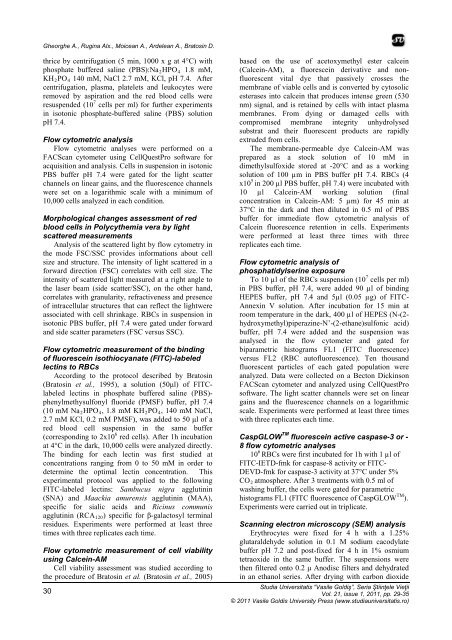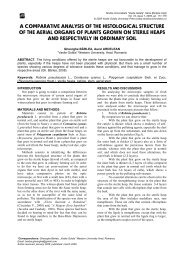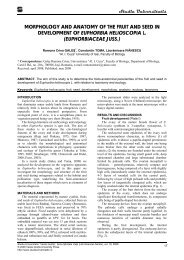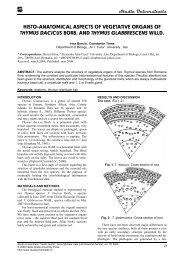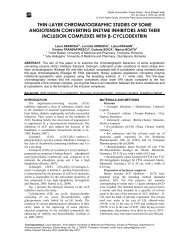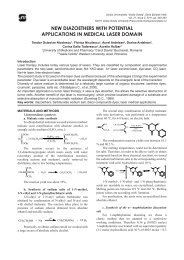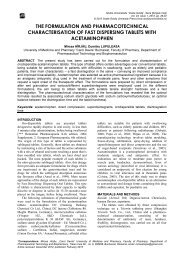flow cytrometric analysis of red blood cells in polycythemia vera
flow cytrometric analysis of red blood cells in polycythemia vera
flow cytrometric analysis of red blood cells in polycythemia vera
Create successful ePaper yourself
Turn your PDF publications into a flip-book with our unique Google optimized e-Paper software.
Gheorghe A., Rug<strong>in</strong>a Alx., Moicean A., Ardelean A., Bratos<strong>in</strong> D.<br />
thrice by centrifugation (5 m<strong>in</strong>, 1000 x g at 4°C) with<br />
phosphate buffe<strong>red</strong> sal<strong>in</strong>e (PBS):Na 2 HPO 4 1.8 mM,<br />
KH 2 PO 4 140 mM, NaCl 2.7 mM, KCl, pH 7.4. After<br />
centrifugation, plasma, platelets and leukocytes were<br />
removed by aspiration and the <strong>red</strong> <strong>blood</strong> <strong>cells</strong> were<br />
resuspended (10 7 <strong>cells</strong> per ml) for further experiments<br />
<strong>in</strong> isotonic phosphate-buffe<strong>red</strong> sal<strong>in</strong>e (PBS) solution<br />
pH 7.4.<br />
Flow cytometric <strong>analysis</strong><br />
Flow cytometric analyses were performed on a<br />
FACScan cytometer us<strong>in</strong>g CellQuestPro s<strong>of</strong>tware for<br />
acquisition and <strong>analysis</strong>. Cells <strong>in</strong> suspension <strong>in</strong> isotonic<br />
PBS buffer pH 7.4 were gated for the light scatter<br />
channels on l<strong>in</strong>ear ga<strong>in</strong>s, and the fluorescence channels<br />
were set on a logarithmic scale with a m<strong>in</strong>imum <strong>of</strong><br />
10,000 <strong>cells</strong> analyzed <strong>in</strong> each condition.<br />
Morphological changes assessment <strong>of</strong> <strong>red</strong><br />
<strong>blood</strong> <strong>cells</strong> <strong>in</strong> Polycythemia <strong>vera</strong> by light<br />
scatte<strong>red</strong> measurements<br />
Analysis <strong>of</strong> the scatte<strong>red</strong> light by <strong>flow</strong> cytometry <strong>in</strong><br />
the mode FSC/SSC provides <strong>in</strong>formations about cell<br />
size and structure. The <strong>in</strong>tensity <strong>of</strong> light scatte<strong>red</strong> <strong>in</strong> a<br />
forward direction (FSC) correlates with cell size. The<br />
<strong>in</strong>tensity <strong>of</strong> scatte<strong>red</strong> light measu<strong>red</strong> at a right angle to<br />
the laser beam (side scatter/SSC), on the other hand,<br />
correlates with granularity, refractiveness and presence<br />
<strong>of</strong> <strong>in</strong>tracellular structures that can reflect the lightwere<br />
associated with cell shr<strong>in</strong>kage. RBCs <strong>in</strong> suspension <strong>in</strong><br />
isotonic PBS buffer, pH 7.4 were gated under forward<br />
and side scatter parameters (FSC versus SSC).<br />
Flow cytometric measurement <strong>of</strong> the b<strong>in</strong>d<strong>in</strong>g<br />
<strong>of</strong> fluoresce<strong>in</strong> isothiocyanate (FITC)-labeled<br />
lect<strong>in</strong>s to RBCs<br />
Accord<strong>in</strong>g to the protocol described by Bratos<strong>in</strong><br />
(Bratos<strong>in</strong> et al., 1995), a solution (50μl) <strong>of</strong> FITClabeled<br />
lect<strong>in</strong>s <strong>in</strong> phosphate buffe<strong>red</strong> sal<strong>in</strong>e (PBS)-<br />
phenylmethysulfonyl fluoride (PMSF) buffer, pH 7.4<br />
(10 mM Na 2 HPO 4 , 1.8 mM KH 2 PO 4 , 140 mM NaCl,<br />
2.7 mM KCl, 0.2 mM PMSF), was added to 50 μl <strong>of</strong> a<br />
<strong>red</strong> <strong>blood</strong> cell suspension <strong>in</strong> the same buffer<br />
(correspond<strong>in</strong>g to 2x10 6 <strong>red</strong> <strong>cells</strong>). After 1h <strong>in</strong>cubation<br />
at 4°C <strong>in</strong> the dark, 10,000 <strong>cells</strong> were analyzed directly.<br />
The b<strong>in</strong>d<strong>in</strong>g for each lect<strong>in</strong> was first studied at<br />
concentrations rang<strong>in</strong>g from 0 to 50 mM <strong>in</strong> order to<br />
determ<strong>in</strong>e the optimal lect<strong>in</strong> concentration. This<br />
experimental protocol was applied to the follow<strong>in</strong>g<br />
FITC-labeled lect<strong>in</strong>s: Sambucus nigra agglut<strong>in</strong><strong>in</strong><br />
(SNA) and Maackia amurensis agglut<strong>in</strong><strong>in</strong> (MAA),<br />
specific for sialic acids and Ric<strong>in</strong>us communis<br />
agglut<strong>in</strong><strong>in</strong> (RCA 120 ) specific for β-galactosyl term<strong>in</strong>al<br />
residues. Experiments were performed at least three<br />
times with three replicates each time.<br />
Flow cytometric measurement <strong>of</strong> cell viability<br />
us<strong>in</strong>g Calce<strong>in</strong>-AM<br />
Cell viability assessment was studied accord<strong>in</strong>g to<br />
the procedure <strong>of</strong> Bratos<strong>in</strong> et al. (Bratos<strong>in</strong> et al., 2005)<br />
30<br />
based on the use <strong>of</strong> acetoxymethyl ester calce<strong>in</strong><br />
(Calce<strong>in</strong>-AM), a fluoresce<strong>in</strong> derivative and nonfluorescent<br />
vital dye that passively crosses the<br />
membrane <strong>of</strong> viable <strong>cells</strong> and is converted by cytosolic<br />
esterases <strong>in</strong>to calce<strong>in</strong> that produces <strong>in</strong>tense green (530<br />
nm) signal, and is reta<strong>in</strong>ed by <strong>cells</strong> with <strong>in</strong>tact plasma<br />
membranes. From dy<strong>in</strong>g or damaged <strong>cells</strong> with<br />
compromised membrane <strong>in</strong>tegrity unhydrolysed<br />
substrat and their fluorescent products are rapidly<br />
extruded from <strong>cells</strong>.<br />
The membrane-permeable dye Calce<strong>in</strong>-AM was<br />
prepa<strong>red</strong> as a stock solution <strong>of</strong> 10 mM <strong>in</strong><br />
dimethylsulfoxide sto<strong>red</strong> at -20°C and as a work<strong>in</strong>g<br />
solution <strong>of</strong> 100 µm <strong>in</strong> PBS buffer pH 7.4. RBCs (4<br />
x10 5 <strong>in</strong> 200 µl PBS buffer, pH 7.4) were <strong>in</strong>cubated with<br />
10 µl Calce<strong>in</strong>-AM work<strong>in</strong>g solution (f<strong>in</strong>al<br />
concentration <strong>in</strong> Calce<strong>in</strong>-AM: 5 µm) for 45 m<strong>in</strong> at<br />
37°C <strong>in</strong> the dark and then diluted <strong>in</strong> 0.5 ml <strong>of</strong> PBS<br />
buffer for immediate <strong>flow</strong> cytometric <strong>analysis</strong> <strong>of</strong><br />
Calce<strong>in</strong> fluorescence retention <strong>in</strong> <strong>cells</strong>. Experiments<br />
were performed at least three times with three<br />
replicates each time.<br />
Flow cytometric <strong>analysis</strong> <strong>of</strong><br />
phosphatidylser<strong>in</strong>e exposure<br />
To 10 µl <strong>of</strong> the RBCs suspension (10 7 <strong>cells</strong> per ml)<br />
<strong>in</strong> PBS buffer, pH 7.4, were added 90 µl <strong>of</strong> b<strong>in</strong>d<strong>in</strong>g<br />
HEPES buffer, pH 7.4 and 5µl (0.05 µg) <strong>of</strong> FITC-<br />
Annex<strong>in</strong> V solution. After <strong>in</strong>cubation for 15 m<strong>in</strong> at<br />
room temperature <strong>in</strong> the dark, 400 µl <strong>of</strong> HEPES (N-(2-<br />
hydroxymethyl)piperaz<strong>in</strong>e-N’-(2-ethane)sulfonic acid)<br />
buffer, pH 7.4 were added and the suspension was<br />
analysed <strong>in</strong> the <strong>flow</strong> cytometer and gated for<br />
biparametric histograms FL1 (FITC fluorescence)<br />
versus FL2 (RBC aut<strong>of</strong>luorescence). Ten thousand<br />
fluorescent particles <strong>of</strong> each gated population were<br />
analyzed. Data were collected on a Becton Dick<strong>in</strong>son<br />
FACScan cytometer and analyzed us<strong>in</strong>g CellQuestPro<br />
s<strong>of</strong>tware. The light scatter channels were set on l<strong>in</strong>ear<br />
ga<strong>in</strong>s and the fluorescence channels on a logarithmic<br />
scale. Experiments were performed at least three times<br />
with three replicates each time.<br />
CaspGLOW TM fluoresce<strong>in</strong> active caspase-3 or -<br />
8 <strong>flow</strong> cytometric analyses<br />
10 6 RBCs were first <strong>in</strong>cubated for 1h with 1 µl <strong>of</strong><br />
FITC-IETD-fmk for caspase-8 activity or FITC-<br />
DEVD-fmk for caspase-3 activity at 37°C under 5%<br />
CO 2 atmosphere. After 3 treatments with 0.5 ml <strong>of</strong><br />
wash<strong>in</strong>g buffer, the <strong>cells</strong> were gated for parametric<br />
histograms FL1 (FITC fluorescence <strong>of</strong> CaspGLOW TM ).<br />
Experiments were carried out <strong>in</strong> triplicate.<br />
Scann<strong>in</strong>g electron microscopy (SEM) <strong>analysis</strong><br />
Erythrocytes were fixed for 4 h with a 1.25%<br />
glutaraldehyde solution <strong>in</strong> 0.1 M sodium cacodylate<br />
buffer pH 7.2 and post-fixed for 4 h <strong>in</strong> 1% osmium<br />
tetraoxide <strong>in</strong> the same buffer. The suspensions were<br />
then filte<strong>red</strong> onto 0.2 μ Anodisc filters and dehydrated<br />
<strong>in</strong> an ethanol series. After dry<strong>in</strong>g with carbon dioxide<br />
Studia Universitatis “Vasile Goldiş”, Seria Şti<strong>in</strong>ţele Vieţii<br />
Vol. 21, issue 1, 2011, pp. 29-35<br />
© 2011 Vasile Goldis University Press (www.studiauniversitatis.ro)


